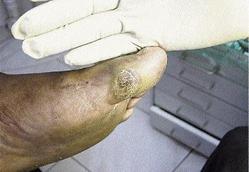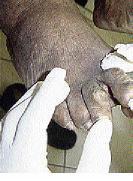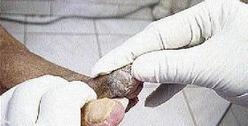Yahneake Sterling, Staff Reporter

- Contributed photos
"Young gal, wear yuh size ..." That is advisable, but comfortable shoes are also important.
In the era when stilettoes and pointy-toe shoes rule the feminine world, style is in and comfort, out.
Our feet take us around daily, yet we abuse them by cramming them into shoes that, realistically, are not made to accommodate a five-toed foot with ease.
The result ... corns and calluses.
Chiropodist/Podiatrist Owen Bernard says that corns and calluses develop due to pressure on the feet.
According to Mr. Bernard, when the physiological process of the skin is interrupted, the skin develops cells to protect the area. Left unchecked, the cells build up and become solid. It then becomes painful as it rests on the nerves.
Poor footwear
Excess pressure to the area caused by poor footwear is the main cause for corns and calluses.
"When you get footwear that is not designed for the individual, your foot has to adapt to the shape of the shoe. Once it begins to adapt, over the years, it will become traumatised and where more pressure is, you're going to get a corn or callus," Mr. Bernard explains.
"A corn does not grow, it builds up. Corns develop over bony areas and if you neglect it, it can develop into other complications," he further noted.
These complications include: infections, ulcers, gangrene and eventually, amputation, especially in diabetic patients.
The difference between corns and calluses? While calluses may look similar, they are different from corns. A callus is simply hard skin that forms at the area where pressure is on the feet.
Like corns, calluses are also caused by footwear.
High heels
An example would be wearing high heels. This puts pressure on the toes. When the prominent joints have excess pressure applied on them, then hard skin develops over a period of time. Under the hard layer, there is soft tissue that can become traumatised, causing a burning sensation.
"Ouch!"
Mr. Bernard points out, however, that both are very treatable but must be accurately and clinically diagnosed.
A chiropodist/podiatrist who is trained to handle these matters should be consulted to rid your feet of the unsightly problem. Ideally, a scalpel or foot file is what would be used to reduce the corn or callus.
Where it concerns over-the-counter treatments, Mr. Bernard has a warning.
"I would not recommend that in the initial stages that you use corn cures that are sold over the counter, because these contain acid, (you can) end up traumatising healthy surrounding tissue and make it worst than what it really is," Mr. Bernard stressed.
He adds that you should be selective in your footwear.
"If every day you put on a shoe you get a burning sensation on the side of your toe, it is telling you something, it is a warning sign, you need to make sure you desist from wearing that particular shoe."
Mr. Owem Bernard is located at the diabetes Association of Jamaica, 1 Downer Avenue.



